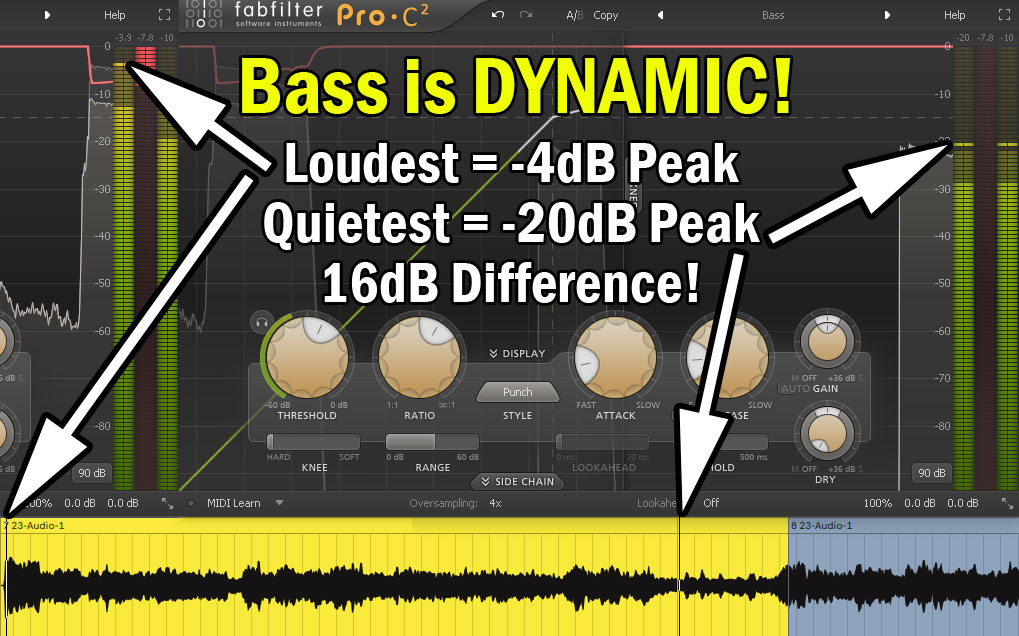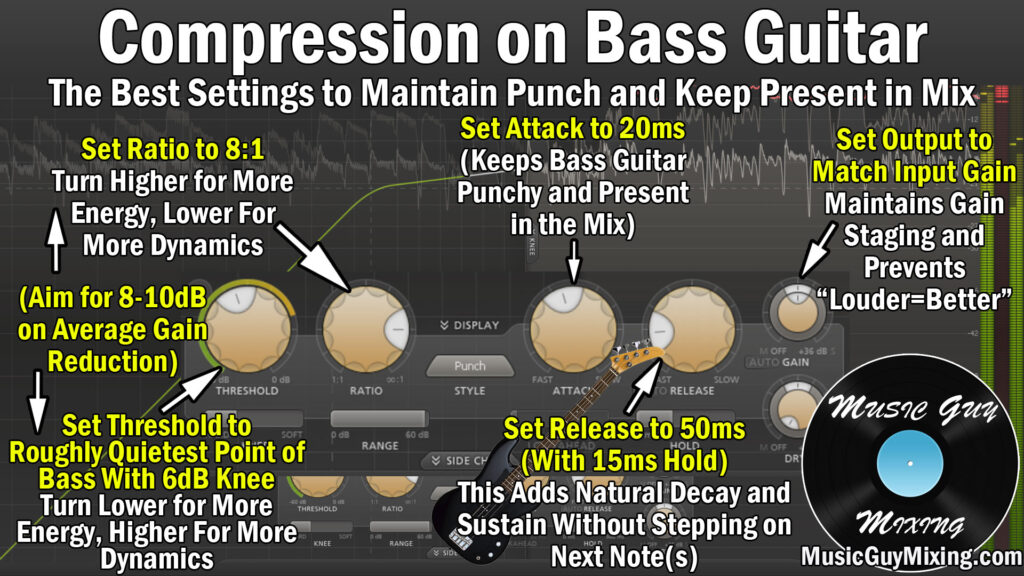Bass guitar is one of the most dynamic instruments. This is due in part to the sensitivity of the strings and the inherent dynamic range associated with it. Factor in a song which fluctuates between quiet and louder sections and you’ll have a bass track which is in desperate need of compression to bring it all together. Let’s talk about how to compress bass guitar.
How to Compress Bass Guitar
I have a sample song and bass performance here to demonstrate the typical dynamics in a bass guitar track. I chose this song at random and immediately found a 16dB swing between the quietest and loudest (performance) parts.

Thankfully, the bass guitar is one of the best candidates for compression. Compression can create a lot of cohesion to bring these extremes closer together and with that cohesion, energy.
These are the settings I recommend to compress bass guitar:

Now let’s go through each one to explain why each setting is the best and what the results will be.
Bass Guitar Compression Threshold
The threshold determines when the signal begins getting compressed. Choosing a point in dB means that anything which exceeds that volume will begin to be compressed. How much it gets compressed is determined by the ratio which we’ll talk about next.

Setting this lower means more of your bass guitar will be compressed.
Because bass guitar is especially dynamic and we want to get it under control with the compression, I like to set the bass guitar compression threshold around the quietest played note on the bass.
This means that the entire bass will be compressed, though admittedly the loudest notes will come down more as they’ll exceed the threshold by more.
I aim for more energy over dynamic range when compressing bass, and this is a great threshold to accomplish that. This helps keep the bass ever-present in the mix, as well.
If you want even more energy and cohesion, go even lower with your threshold. If you’re feeling like the bass has lost its expressiveness, opt to go a bit higher. This will also vary by genre.
In a more stripped down genre like jazz you’ll want to hear that dynamic range difference between the quietest and loudest notes.
In pop or rock, you’ll likely want to include more of the signal and a higher ratio. Speaking of which…
Bass Guitar Compression Ratio
Okay, we set the threshold to compress most of the notes, but how “extreme” will the compression be? This is where the bass guitar compression ratio comes in.
I recommend setting your bass guitar compression ratio at 8:1.

If you’re curious about how the ratio works, check out my overview where I explain compression ratio.
Essentially, an 8:1 ratio means that if you have an instance in which the volume goes over the threshold by 8 dB, it gets turned down to only exceed it by 1, resulting in 7dB of gain reduction in that case (8-1=7).
Everything below the threshold is untouched, and everything which exceeds the threshold the most will be attenuated the most, so the difference between the quietest and loudest points (the dynamic range) is reduced.
8:1 is a admittedly an aggressive ratio for compression, but bass is one of those instruments which, particularly in genres like pop and rock, we want to sacrifice some of the life which it gets from its dynamic range to keep it present in the mix.
I like this ratio on bass in particular as it smooths out the performance to be pretty consistent. All notes should be able to be heard, and it stays in the mix to give you a constant low end presence in your bass guitar.
By the way, I didn’t mention this in the last point, but set your compression knee to around 6dB. The lower the knee in decibels, the harder it’s considered to be. This basically ensures that the 8:1 ratio is strictly enforced along with the ratio.
Bass Guitar Compression Attack
The bass guitar compression attack determines how fast after the threshold is exceeded that the ratio is enforced and those peaks are turned down.
We want to leave a microsecond of the signal untouched so we can hear the dry (uncompressed) bass cut through the mix before the compression kicks in.
I like a relatively slow bass guitar compression attack of 20ms:

This leaves enough time for those transients to make themselves heard before we get the benefits of the compression.
Try experimenting with a longer attack time if you feel like the bass is disappearing in the mix, but this is a great starting point.
Bass Guitar Compression Release
The final setting to consider when understanding how to compress bass guitar is the release time. Conversely to the attack, this determines how soon after the signal drops below the threshold that it stops compressing the signal.
Set your bass guitar compression release to 50ms to leave a natural drop off of the compression. I even like to “pad” that release time with a very short hold time of 15ms (see hold vs release time on a compressor). This adds 15ms of full compression even after the level drops below the threshold:

This is a sweet spot to where we get a natural return to the uncompressed signal without overlapping on to the next note. Of course you may need to adjust this depending on the tempo of your song and energy “profile” of the bass performance.
You can experiment with this setting, but note if you set it too short you’ll hear the compression letting go which we don’t want. We typically want compression to be transparent (unless we’re working in EDM and want that trademark “pumping” sound).
Bass Guitar Compression Gain
I always say this last bit, but whenever you’re using compression, make sure the input and output gain are the same:

In other words, the volume should sound roughly the same with or without the compression on.
This helps to ensure that the compression is helping and the louder signal doesn’t trick your ears to win out. This also sets your track up nicely for whatever the next plugin is in the chain (see my gain staging cheat sheet).
Tips to Compress Bass Guitar
- Bass guitar is one of the most dynamic instruments. As such, compression can add cohesion and glue as well as energy to virtually any performance.
- Set your bass guitar compression threshold to a little below the average volume. This ensures that most of the performance will be compressed. Aim higher if you lose the expressiveness of the bass, and lower if you want more energy and cohesion.
- Set your bass guitar compression ratio to 8:1. This is an above average ratio to give you a decent amount of control over the peaks and overall signal on your bass guitar. Aim lower if you want more expressiveness, or higher if you want more energy and cohesion.
- The bass guitar compression attack speed should be relatively average. 20ms makes the compression responsive without sacrificing transients.
- Set the bass guitar compression release to 50ms and 15ms of hold to pad that time out. This provides a smooth off ramp for the compression without stepping on the next note(s). Add sustain with 50ms or so of hold on the compressor.
- Don’t forget to match your output gain to your input to make unbiased decisions when referencing the audio with and without the compression.

Pingback: Audio Effects Explained - The Complete Guide - Music Guy Mixing
Pingback: Serial Compression - The Ultimate Guide - Music Guy Mixing
Pingback: What is the Automatic Compression Release - Music Guy Mixing
Pingback: Electric Guitar Compression Guide - How to Compress Electric Guitar - Music Guy Mixing